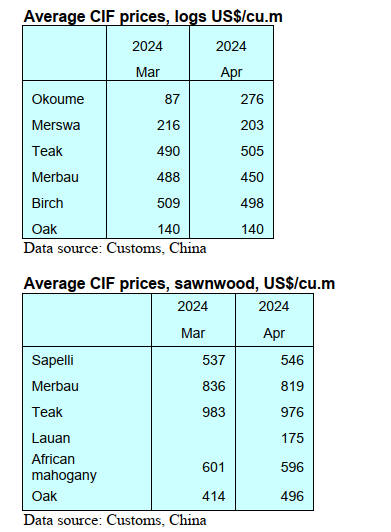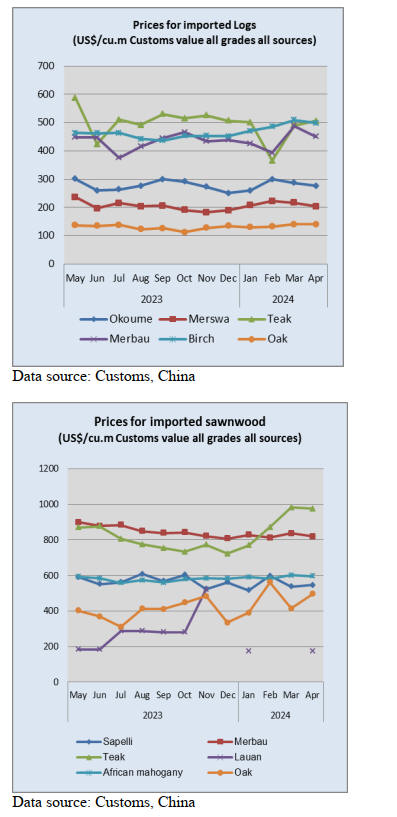US Dollar Exchange Rates of
25th
Jun
2024
China Yuan 7.26
Report from China
Equipment upgrades and trade-ins
The Chinese government recently took action to facilitate
economic transformation and improve people's
livelihoods.
The campaign is market-oriented and government-guided
and includes four major areas: equipment renewals, trade-
ins of consumer goods, recycling of used goods and the
harmonisation of standards.
The priority is equipment upgrades in promising industries
in order to accelerate the elimination of out dated or
inefficient equipment with high energy consumption, high
emissions or hidden safety risks. A focus will be on
accelerating the development of recycling systems and
development of enterprises engaged in the processing and
utilisation of renewable resources.
The scheme for trade-ins of household consumer goods is
aimed at supporting residents to carry out interior
renovations for kitchens and bathrooms through various
ways with government support and enterprise discounts.
The aim is to promote old home transformation and
actively cultivate consumption of items such as smart
home technologies, promote home improvement and
encourage enterprises to create online model rooms,
provide affordable products and services and meet
diversified consumer needs.
It has been reported that the effect of the ‘old for new’
policy started in May 2024 came to coincide with the May
Day holiday and traditional peak purchasing season. It was
found that consumption of building materials and home
furnishing was stimulated.
See:
https://www.gov.cn/gongbao/2024/issue_11246/202403/content_
6941843.html
Analysis of the wood flooring industry
The output, consumption and export volume of China's
wood flooring are ranked first globally. Wood flooring is
an important end product and value-added product.
However, China's wood flooring production has been in
decline in recent years. After the peak in 2019 most
enterprises have suffered a profits decline and the
industrial prospects are grim.
Tough times for laminate and solid wood flooring manufacturers
The development of China’s wood flooring industry is
basically stable. According to statistics from China
National Forest Product Industry Association (CNFPIA)
the total sales of wood flooring by enterprises with an
annual income of RMB20 million or more in 2023 was
about 322 million square metres, down about 9% year-on-
year.
Of total sales, laminate wood flooring sales were 142
million square metres, accounting for 44% of the national
total. Sales of solid wood composite flooring amounted to
120 million square metres, accounting for 37%, sales of
solid wood flooring was 30 million square metres,
accounting for 9%, the sales of bamboo flooring came to
25 million square metres, accounting for 8% and sales of
other flooring amounted to 5 million square metres,
accounting for 2% of the national total.
China's wood flooring industry showed a steady
development trend from 2010 to 2023 and the volume
sales of wood floors climbed to the highest of 425 million
square metres in 2019 and fell to the lowest of 322 million
square metres in 2023.
The volume of laminate wood flooring and solid wood
flooring sales experienced a steep declining trend but sales
of solid wood composite flooring increased steadily and
the sales of bamboo flooring remained stable. At present
there are more than 93 national standards and industry
standards closely related to wood flooring covering
product testing methods, safety and environmental
protection, services and supporting facilities, equipment
and raw materials, grade and evaluation.
Currently, mechanisation, automation and digitalisation by
enterprises coexist but their development is unbalanced in
different regions and different enterprises. The wood
flooring industry is shifting from product driven to
innovation and data-driven.
Many wood flooring companies have set up technology
centres, R & D centres or research institutes, conducting
research and development mainly around innovative floor
connection methods, innovative substrates or surface
decoration materials, optimising product structure,
upgrading product performance and enriching product
functions.
The number of authorised invention patents in wood
flooring industry reached 514 in 2023. New products such
as solid wood floors for floor heating, impregnated paper
veneer solid wood composite floors, stone-wood plastic
floors, reconstituted bamboo floors, moisture-proof
laminate floors are popular in domestic and foreign
markets.
Existing difficulties in the wood flooring industry
--- With the rise of labour costs and product
homogenisation it is hard to get out of the middle
and low-end market for wood floors.
--- With the rise of foreign trade protectionism and
the evolution of domestic market demand China’s
wood flooring is facing the situation of declining
competitive advantage and brand advantage.
--- Due to the vicious competition and lack of
innovation of the wood flooring industry itself the
overall share of the floor paving materials market
at home and abroad is facing a crisis of decline.
--- Sales of wood flooring are becoming more and
more difficult as products and services do not
effectively meet market demand. The urgent need
is to change from product oriented to user
experience oriented, the implementation of
demand driven, "can let consumers in the use of
products or services to be met" as the standard for
enterprise transformation and upgrading.
Thriving timber industry in Heze City
As of June 2024 there were 7,716 wood processing
enterprises in Heze City of Shandong Province, the annual
processing volume of wood reaches 31 million cubic
metres, the output value of wood processing is more than
RMB110 billion in 2023.
There are more than 1 million employees and its wood
products are exported to more than 100 countries and
regions. Exported products cover medium and high-
density fiberboard, furniture and wood floors and wooden
crafts.
Statistics shows that in the first quarter of 2024 there were
789 wood processing enterprises with output value of
RMB20 million or more in Heze City, an increase of 170
enterprises compared with August 2023, accounting for
28% of the city's industrial enterprises; The revenue was
RMB17.89 billion and the profit was RMB1.42 billion, up
15% and 31% year-on-year.
Production centre for sport flooring
Driven by the development of sports and the rise of a
national fitness craze demand for sports flooring has
expanded away from only competitive sports arenas into
individual’s exercise areas. Sales of sport flooring have
been increasing and a new market with potential for the
flooring industry has emerged.
At present, there are 120 wood sports flooring production
enterprises in Fushun City accounting for 60% of the
number of domestic enterprises engaged in this sector. The
production and sales of sports floor reached 6 million
square metres accounting for about 60% of the domestic
market. Fushun City won the title of "China Sports Floor
Industry Base" in 2023 becoming the only city in China to
win this honor.
Sports flooring is mainly solid wood flooring and solid
composite wood flooring. The species used for sports
flooring are mainly pine, oak, maple and birch.
Global Timber IndexReport – China, May 2024
Data released by China’s General Administration of
Customs on 9 May showed that China’s exports of
furniture and furniture parts between January and April
2024 reached US$23.725 billion representing a year-on-
year increase of 16.5%.
During the same period China’s total imports of logs and
sawnwood were 21.864 million cubic metres, marking a
year-on-year increase of 0.3%. Among them, rubberwood
imported from Thailand reached over 1.69 million cubic
metres indicating a notable year-on-year increase of 32%.
The volume of timber imported from Gabon also increased
significantly (+85%), reaching 0.27 million cubic metres.
On 17 May the People’s Bank of China and the National
Financial Regulatory Administration issued a notice once
again lowering the interest rate for personal housing loans
and reducing the down payment ratio.
Stimulated by a series of new policies for the property
market introduced in the first half of this year the
operating rate in the construction sector rose and demand
for construction wood was gradually recovering. Due to
factors such as geopolitical conflicts and freight charges
enterprises input costs keep on rising.
Maersk, Hapag-Lloyd, CMA CGM, COSCO Shipping and
other shipping companies announced increases in freight
rates which will push up the prices of raw material import
costs.
In May the GTI-China index registered 42.2%, a decrease
of 10.1 percentage points from the previous month and fell
below the critical value (50%) after 2 months indicating
that the business prosperity of the timber enterprises
represented by the GTI-China index shrank from the
previous month.
Due to factors such as a decrease in domestic and foreign
timber demand and the Labour Day holiday, China’s
timber sector saw a decline in both orders and production
volume and some GTI enterprises reported an
overstocking problem.
As for the 11 sub-indices, two indices (inventory index of
finished products and inventory of main raw materials)
were above the critical value of 50% and the remaining 9
indices were all below the critical value.
Compared to the previous month the inventory index for
finished products and the inventory index for main raw
materials increased by 1.8-8.3 percentage points while the
remaining 9 indices declined by 5.0-19.1 percentage
points.
See:
https://www.itto-ggsc.org/static/upload/file/20240620/1718839024156844.pdf


|